The COP29 climate conference is revealing a significant shift in the dynamics of global climate negotiations, particularly with the expected retreat of the United States under President-elect Donald Trump, who has openly criticized climate action as a “scam.” This development has led many observers to label COP29 as one of the most challenging conferences yet, with negotiations stagnating as parties struggle to reach consensus. Hope, however, is emerging from an unlikely source: China.
Historically, China has oscillated between aligning with Western nations on ambitious climate targets and resisting calls for accountability. Notably, during COP15 in Copenhagen, China resisted pressure to agree to international monitoring of its emissions. Yet, the mood at COP29 has shifted, as China has adopted a more cooperative stance, especially in its commitments to provide substantial climate funding to developing nations. Reports indicate that China has offered over $24 billion in climate aid since 2016, signaling a willingness to take on a more prominent role in climate finance.
China's unique position as a developing country, despite being the world’s second-largest economy, has allowed it to keep some responsibilities at bay while still seeking to uphold its influence at climate talks. This year, however, the country has exhibited a new approach by openly sharing details about its financial contributions, invigorating discussions among delegates.
Analysts believe that China's surge in renewable energy production, led primarily by its robust private sector, is a key motivator for this change. With over 80% of global solar panels manufactured in China, as well as significant stakes in wind energy and electric vehicles, the nation is now looking to capitalize on the developing world’s burgeoning demand for clean energy technologies.
This evolving narrative is tied to China’s broader economic strategy as articulated through its Belt and Road Initiative, aiming to expand trade routes and connect with emerging markets. This initiative aligns seamlessly with China’s new role in climate talks, as it strengthens its position as a provider of renewable technologies while promoting emissions reductions globally.
Should China indeed take on a leadership role in COP discussions, it would fundamentally alter the landscape of international climate negotiations that have historically been dominated by Western powers. Experts predict that while China may not lead assertively, it could contribute to resolving disputes behind the scenes, potentially fostering collaboration between developing and developed nations.
However, challenges remain. Nations like Saudi Arabia have consistently pushed back against the transition to renewable energy, complicating the collaborative potential of COP29. Despite this, some observers see a shift in climate talks toward a focus on economic viability rather than political posturing, suggesting that where the US falters, China may thrive, leveraging its clean technology advancements for mutual benefit in a vast emerging market.
In conclusion, while uncertainty looms over the COP process with the US stepping back, China's proactive engagement could herald a new era of international climate collaboration, ensuring that the dialogue continues to evolve in pursuit of crucial global emission reductions.





















